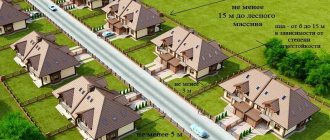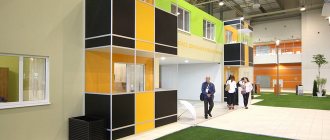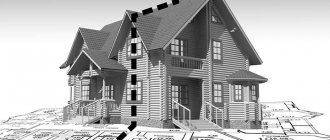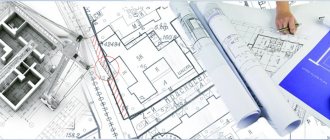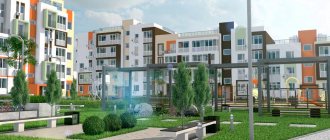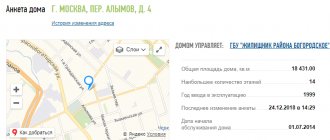West Garden (Ramenki)
Yards and own natural park – 15 hectares
Prices: from 17 million rubles
The West Garden business class complex is designed according to the principles of greenfield development, which implies the creation of a residential environment in previously unused areas. According to the approved project, 80% of the West Garden area will be improved. The residential complex is adjacent to an untouched island of wildlife inside the Moscow Ring Road. It has its own access to the embankment of the Ramenka River, a strip of reclaimed natural park, multi-tiered terrain with additional planting of more than 1,500 different trees and shrubs, as well as more than 80 species of herbs and flowers. In addition to 7 hectares of landscaped space along the Ramenka River with running and walking routes, a pedestrian bridge will be equipped, playgrounds and sports grounds will be built.
The courtyard of the complex will also be organized as a large park with colorful gardens, which will be connected by a walking boulevard. The concept provides for 6 types of gardens: white, scarlet, meadow, lilac, steppe and fragrant. The courtyard space of the complex will be divided into several functional zones, designed for comfortable recreation for residents of all ages. In total, the landscaped area will be 15 hectares after the completion of all three phases of the project, taking into account the 7 hectares of landscaped embankment area and courtyards with colorful gardens.
Scandinavia (Sosenskoye settlement, New Moscow)
Own park – 10 hectares
Prices: from 6 million rubles
Residents of several buildings of the Scandinavia residential complex (A101 residential complex), leaving the house, find themselves in a landscaped linear park with an area of 10 hectares. Its concept and design code were developed by the Dutch architectural bureau MLA+. The landscaping and landscaping reflected the main features of typical Scandinavian nature. The central place in the park is occupied by a natural reservoir with a cleared bottom, a fortified embankment and mature trees preserved along its banks.
According to the concept of improvement of the Scandinavia residential complex, “place guardians” will be installed throughout the residential complex - sculptures of animals and fairy-tale creatures from Scandinavian mythology. In forest and coastal areas, on paths to homes, schools and kindergartens, residents can encounter statues of a bear or deer, a troll or a gnome. These are important markers of territory and points of attraction for residents. In particular, in the Linear Park there is a sculpture of the mythical deer Eikturnir.
Residents can get to the other side of the stream, to the rest of the residential buildings, to the pedestrian promenade and to the kindergarten via the “troll bridge.” The durable metal structure is lined with wood slats to maintain the authenticity of Scandinavian design.
Seliger City (Western Degunino)
Yard with park and pond – 6.1 hectares
Prices: from 9 million rubles
In the Seliger City business class residential complex, the developer MR Group provided not only its own park, but also an artificial pond. The internal space of phases 1 and 2 of the complex, surrounded by multi-storey buildings, is equal in area to four football fields. It will be comfortable here for lovers of hiking, calm, measured relaxation, athletes and children. Sports and children's playgrounds, a multifunctional area for sports games, jogging tracks, and shade canopies have been built on the internal territory. On the shore of the artificial pond there are areas for recreation and picnics, as well as a cafe with summer terraces. Residents of the complex will be able to sunbathe on sun loungers near the pond without leaving Moscow or their neighborhood. Active landscaping has been done throughout the entire yard: flower beds, shrubs and large trees have been planted.
The courtyard of the 3rd stage includes the construction of workout zones and its own skate park with an area of more than 500 sq.m. from FK-RAMPS, as well as areas for walking pets.
Traffic in residential areas
In the Rules, the term “Residential zone” is given a broader meaning than in urban planning practice or everyday life. This can be not only the territories of the so-called urban “dormitory” areas, but also individual streets (or sections of streets) in the business and commercial part of the city, where it is necessary to provide more favorable conditions for pedestrians, without prohibiting the movement of vehicles altogether.
There is an opinion among drivers that the rules of movement in residential areas apply only when there is a corresponding sign at the entrance to such an area - a schematic image of a house and people on a blue background (clauses 5.21 and 5.22 of the traffic rules). In fact, the rules must be followed in all internal passages and courtyards. The easiest way to distinguish a residential area from a small street or alley is by toponymy - internal passages do not have official names.
In a residential area, the speed is limited to 20 km/h (clause 10.2), and priority remains with pedestrians, who are allowed to move both on sidewalks and on the roadway. However, the rules prohibit pedestrians from intentionally obstructing traffic. Thus, if there is a sidewalk along the road, the pedestrian should move along it.
In addition, through traffic is prohibited in courtyards (although motorists like to avoid traffic jams in courtyards), practice driving, and parking with the engine running (more than 5 minutes). However, in cold weather, drivers are tacitly allowed to deviate from the parking requirement if it is necessary to warm up the engine and clear the snow from the car. Well, drivers of heavy vehicles with a curb weight of more than 3.5 tons do not have the right to park their vehicles in courtyards and residential areas.
Prime Park (Khoroshevsky district)
Private park – 3.5 hectares
Prices: from 18.3 million rubles
Another large-scale courtyard will be turned into a park as part of the premium Prime Park project from Optima Development. Residents will have exclusive access to a private park in the neighborhood's courtyard, measuring more than 3.5 hectares. Experts and architects from a special division of the Dyer company, which has 50 years of experience in creating parks and recreation areas in England, worked on the design of the park. The park space consists of individually designed zones and a large central area with walking paths. Residents of the quarter will be able to spend time here as they wish - from leisurely walks along the alleys to active games on the children's playgrounds. A large amount of greenery and trees, many walking paths, benches overlooking decorative elements of the landscape, multi-level lighting, fountains, sculptures and art objects - all this forms a picturesque landscape in the center of the quarter.
How to find out the boundaries of your yard and what is it for?
We explain how to determine the size of the local area and what it affects.
Krasnoarmeyskaya Street before leaving Surikov Street has become impassable: it is blocked by residents of nearby houses who consider it their yard. It seems to me that this is the carriageway of the street, if you look at the city map. Where can I go for clarification and who can correct the situation if the territory is considered a street and not a courtyard area?
Data on the boundaries of land plots can be viewed on the public cadastral map of the city of Kirov. According to this map, a land plot with cadastral number 43:40:000367:73 occupies the territory of Krasnoarmeyskaya Street, which you considered illegally blocked. This section is not part of Krasnoarmeyskaya Street at all, since it ends at the intersection with Turgenev Street.
On Google.Maps the driveway is assigned to Krasnoarmeyskaya Street, but on Yandex.Maps, 2gis and the public cadastral map it is simply an entrance to the house from the street. Surikov.
What is a local area and who owns it?
The local area is not only the yard itself with a playground, benches and green spaces. It also includes fire passages and utilities that ensure the functioning of the house.
On this topic
What if your neighbors leave their cars in your yard?
10740
According to Art. 36 of the Housing Code of the Russian Federation, the land plot on which the apartment building is located belongs to the owners on the right of common shared ownership. Like non-residential premises, it belongs to common property.
It is necessary to know the boundaries of the local area so that in controversial situations it is possible to defend the interests of the residents of the house. For example, if trees in your yard have begun to be cut down for the construction of some object or there is reason to believe that a house being built next door may take up part of your yard. It is also useful to know the boundaries in order to control the work of the management company in cleaning the yard.
Please note that residents cannot restrict access to the local area for special services vehicles and create any obstacles to the maintenance of utilities and landscaping of the site. Also, part of the adjacent territory cannot be transferred for use to the individual owner of one of the apartments. For example, if your neighbor fenced off a space in his yard to park his car, his actions are illegal.
How to find out the boundaries of the local area?
The adjacent territory is determined during the construction of an apartment building based on the norms of the city’s urban planning regulations (you can download it from the link) and the Land Code of the Russian Federation. The parameters of the local area - area and boundaries - are displayed in the cadastral passport of the house, which can be requested from your management company. Or you can find your address on a public cadastral map. You can also see on the urban zoning map which zone of use a particular site belongs to.
If the land plot on which the apartment building is located was not formed before the adoption of the Housing Code of the Russian Federation (it came into force in 2005), then its boundaries, according to Valery Semenishchev, chairman of the board of the apartment building on Lenin, 20, can be determined as follows:
- Contact the MKU "Architecture" and obtain information about the boundaries of the land plot;
- Create a land survey plan - for this you need to contact private land surveying specialists;
- According to the concluded agreement, the surveyor will register the land plot with the MFC, after which the owners will receive an extract about the land plot;
- On your own, with an extract about the land plot, an extract about the ownership of the premises in the apartment building and other documents, you need to contact the MFC and register a share in the ownership.
After this, the local area will be determined.
Briefly about the main thing:
- The adjacent territory belongs to all owners in the house on the right of common ownership.
- The boundaries of the local area can be found using the public cadastral map, which is available online, or you can request a cadastral passport for the house from your management organization.
- If the boundaries of the local area are not defined, this can be done by contacting the relevant authorities. After the site is demarcated, the owners will be able to defend their interests.
If you have questions that you can't find the answer to, ask us and we will try to answer them.
On this topic
10627
Who should repair sidewalks in the yard?
Paveletskaya City (1st and 2nd stages) (Danilovsky district)
Eco-friendly yard – 2.7 hectares
Prices: from 12.7 million rubles
To improve the territory of the Paveletskaya City business class project, developers MR Group and Level Group hired the experienced ADM bureau. ADM takes an environmentally friendly approach to planning its territory. In the fenced area, play complexes for children of different ages, quiet recreation areas, sports grounds, a health path, and multifunctional areas for team sports will be built. The courtyard in Paveletskaya City is distinguished by an abundance of greenery, landscape design and conceptual multi-level space. Residents will be able to relax in a specially equipped picnic area while children play in one of two playgrounds designed for different ages. Trampolines and other sports and play equipment will be installed here.
Silver Park (Khoroshevsky district)
Multi-level recreation and activity area – 2.3 hectares
Prices: from 18 million rubles
For residents of the Silver Park business class complex, the developer will create a landscaped area for recreation and activity in the courtyard from the WOWHAUS architectural bureau. Various functional areas will be built for sports fans: a workout area with equipment from FOREMAN, as well as an area with street chess. In addition, a lot is provided for children's leisure near the house: environmentally friendly playgrounds with a sand station and an excavator, a streetball court, a balance board and a ping-pong table, swings and hammocks under canopies. Children's playgrounds will also be equipped for the built-in bilingual kindergarten. There are also places for adults to relax quietly. “Silver Park” will create corners for relaxation and meditation, wooden flooring for yoga, an area with sun loungers, and a picnic area. All this is surrounded by a designer natural landscape, all-season trees and shrubs. The developer did not forget about residents with dogs - they provided an area for walking and training their beloved pets.
Residential zone: who can enter it, what cannot be done in it and what you can get a fine for
What is a residential area?
The traffic rules provide a rather formal definition of a residential zone: the description of the corresponding sign 5.21 states that a residential zone is a territory in which the requirements of the rules are in force, establishing the procedure for traffic in a residential zone
. In practice, residential areas mainly include courtyards and adjacent areas where infrastructure is organized for walks, entertainment and recreation for residents of nearby houses. To ensure safety, including for children, residential areas are designated. The exit from them is indicated by the corresponding sign 5.22 “End of the residential area”.
Traffic in residential areas is regulated by a separate section 17 of the traffic rules. It is worth noting that paragraph 17.4 indicates that the requirements of this section also apply to courtyard areas
.
At the same time, there is no definition of yard territory in the traffic rules, and there is no corresponding sign indicating the entrance to such territory. So here we just have to rely on common sense and related legislation. For example, the law of the Moscow region on landscaping contains a definition that a courtyard area is an area adjacent to a residential building and is in common use by the persons living in it, limited along the perimeter by residential buildings, structures, structures or fences. Therefore, when moving through the courtyard of a residential building that is not marked with a “Residential Zone” sign, it is worth remembering that the absence of a sign does not indicate a lack of responsibility
.
Who can enter the residential area?
First of all, it is worth noting that sign 5.21 “Residential zone” belongs to the category of signs of special requirements and does not prohibit the movement of vehicles. There are no restrictions on entry: all drivers can enter the residential area
, and not just those living in this zone, as is organized with some other signs. So you shouldn’t be afraid of the “Residential Zone” sign at the entrance to the yard: it does not restrict traffic, but only informs you about entering a zone with separate traffic rules.
How fast should you drive in a residential area?
The speed of movement in a residential area is regulated not by section 17, but by clause 10.2 of the traffic rules. It indicates that in residential areas and courtyard areas it is allowed to drive at a speed of no more than 20 km/h
.
What is the difference between a residential area and other areas?
The main difference between the residential area is the priority of pedestrians over cars. Paragraph 17.1 of the traffic rules indicates that in a residential area, pedestrian movement is permitted both on sidewalks and on the roadway
, in this case
pedestrians have priority
.
That is, a pedestrian can cross the road or move along it anywhere, and the driver is obliged to let him through. This obliges the driver to strictly maintain speed and be extremely careful. After all, for example, in a situation where a pedestrian suddenly comes out from behind a parked car, the driver is also obliged to stop and give him priority in traffic. The only fair requirement for pedestrians, contained in the same paragraph 17.1, indicates that pedestrians must not unreasonably interfere with the movement of vehicles
. That is, you cannot simply stand on the road or otherwise deliberately interfere with travel.
What should you not do in a residential area?
In addition to driving at a speed above 20 km/h in a residential area, other actions listed in paragraph 17.2 of the traffic rules are prohibited. So, in a residential area it is prohibited
:
- through traffic of motor vehicles;
- training ride;
- parking with the engine running;
- parking of trucks with a permissible maximum weight of more than 3.5 tons outside specially designated areas marked with signs and (or) markings.
Through movement is movement without stopping. It is prohibited so as not to congest a residential area with passing cars: for example, a residential area cannot be used as a detour if there is a traffic jam on a nearby road.
With training driving and truck parking, everything is clear: they have no place in an area where pedestrians dominate. But parking with the engine running deserves special clarification. According to the traffic rules, parking is the deliberate interruption of the movement of a vehicle
for a period of more than 5 minutes
for reasons not related to the embarkation or disembarkation of passengers or the loading or unloading of a vehicle. That is, if a car is parked in a residential area for more than 5 minutes with the engine running, its driver is breaking the rules. And this is quite possible - for example, in winter, when the car is warmed up before the trip. Therefore, when warming up the car, it is worth remembering that possible complaints from the residents of the house about the long warm-up are quite justified.
What should you consider when leaving a residential area?
When leaving a residential area, it is worth remembering clause 17.3 of the traffic rules: it indicates that when leaving a residential area, drivers must give way to other road users
. And this includes not only cars, but also pedestrians.
What punishment can you get for violations in a residential area?
Violations of traffic rules in a residential area are punishable under a separate article of the Administrative Code - 12.28. Part 1 of this article states that violation of the rules established for the movement of vehicles in residential areas entails an administrative fine of 1,500 rubles
.
And part 2 doubles the fine for Moscow and St. Petersburg: a violation provided for in part 1 of this article, committed in a federal city of Moscow or St. Petersburg, entails an administrative fine of 3,000 rubles
. In this case, the type of violation does not matter: you can be fined both for training driving and for driving through a residential area, if this fact is established by the inspector.
Separately, it is worth mentioning about speeding. Driving speed is not included in the list of “rules established for the movement of vehicles in residential areas” from Section 17 of the Traffic Regulations, so here penalties for exceeding are standard. And despite the fact that the courtyards of houses are definitely not covered with speed cameras, you should not feel false impunity. For example, if in the case of an accident in a residential area, a trace analysis establishes the fact of excess, this will be taken into account as an aggravating circumstance. Yes, and children running out from behind cars parked in the yard have not been canceled.
River Park (Nagatinsky backwater)
Yard area – 1.5 hectares
Prices: from 10.9 million rubles
In May, sales of the building of the 4th city block of the business class “River Park” from AEON Corporation and Ferro-Stroy started. It has many features: in addition to the fact that this is the last phase of one of the best-selling residential complexes in Moscow, recognized as a “Hit of Sales” according to the “Real Estate Market Records 2021” award, it will be distinguished by very successful and large-scale landscaping. Most of the apartments in the building will have views of the Moscow River, since it is being built on the first coastal line, and next to it a one and a half kilometer embankment has been built, which has become the calling card of the project.
The adjacent territory of the building is one of the largest in the city, with an area of 1.5 hectares, the concept of improvement of which was worked on by the famous landscape bureau AFA. Residents will be able to admire the city, arrange Instagram sessions on observation decks or in the rock garden. It is planned to equip and decorate the private territory with all-season landscaping, which will become elements of the water landscape.
A river pool will appear in the courtyard, over which an elegant pedestrian bridge will be built. A ceremonial central staircase with a picturesque dry stream will also be built here. On the boulevard next to the building, residents of the complex will be able to play sports in an area for street training, a climbing wall, a roller skating rink and a multifunctional area, which will turn into a skating rink in winter.
Residential zone sign
A residential zone is an area whose boundaries are indicated by road signs 5.21 and 5.22.
Section 17 of the Highway Code requires a number of rules to be followed within this zone. In courtyard areas, these rules are also mandatory. Previously, the traffic rules did not contain a “Residential zone” sign, so still not every driver fully understands what is hidden under this concept, what speed is considered acceptable, and what fine will be imposed if it is exceeded. A limited area is considered residential, which is marked on both sides with appropriate signs. The traffic rules now have a whole section dedicated to driving through such territories.
The residential zone is an area whose boundaries are indicated by road signs 5.21 and 5.22
It is worth noting that in this area a pedestrian has an advantage over absolutely any vehicle.
He can walk both on the sidewalks and on the road itself, so the speed at the “Residential zone” sign should be reduced to 20 km/h. The pedestrian has an undeniable advantage over the driver, who must give way to him. True, a pedestrian also needs to be alert - there is no point in deliberately creating an obstacle in the path of a car. Even without a "Cycling" sign in this area, cyclists also have additional benefits.
Within the residential area, the same traffic rules apply as elsewhere. But others are added to them:
- Motorists are prohibited from leaving their car in a parking lot with the engine running. The engine must be turned off immediately if the vehicle is stationary for more than 5 minutes;
- a strict ban has been imposed on stopping and parking a car on the lawn;
- through traffic is strictly prohibited;
- training driving is prohibited;
- Parking of trucks weighing more than 3.5 tons is prohibited. There are special parking lots with marked spots for them.
- when moving out of this territory, the driver must give way to other vehicles;
- Maneuvering according to traffic rules is carried out only in cases of extreme necessity.
